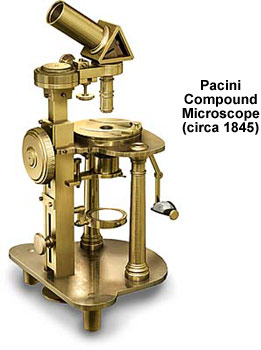Pacini Compound Monocular Microscope
Filippo Pacini was an Italian instrument maker who excelled in microscope design and construction during the mid nineteenth century. The microscope illustrated below is an example of the microscopes produced by Pacini. An original version of the microscope was photographed and described by Gerard Turner in his book Catalogue of Microscopes.

The base is a flat semi-circular brass plate, similar to another Pacini microscope featured in the museum, supported by three short tapered feet, with the limb and two large columns emerging from the flat surface. This version has longer feet than its cousin, the rotatable stage is not divided, and the eyetube/ocular combination is much shorter. In addition, this Pacini model has an Amici prism with an aperture on a hinged brass arm that protrudes from the front of the stage. An oval stage housing is positioned at the top of the columns and has plenty of room to accommodate a wide spectrum of specimens. The back portion of the stage is supported by a large rectangular brass limb, which contains a trapeze-sectioned bar carrying the arm to which the body tube is attached. This inner bar is attached to a locking screw that controls a long vertical iron screw serving as the fine focus mechanism through a knurled wheel positioned under the base. A circular stage has 360-degrees of rotation and can be translated in the Y-direction by a screw with a calibrated wheel on the back of the pillar. Below the stage is a set of four apertures and a single-lens condenser that can travel up and down on a brass rod. Light is projected into the condenser lens by means of a plano-concave mirror.
BACK TO NINETEENTH CENTURY MICROSCOPES
